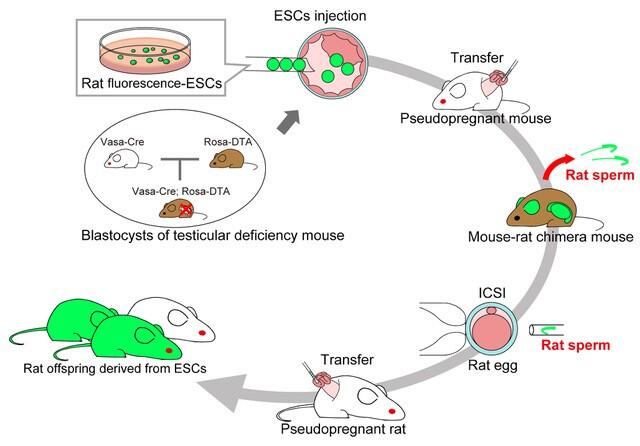2025.07.07
Fertilizable rat sperm produced in a mouse body by blastocyst complementation
A novel, cost-effective strategy for generating genetically modified rats using ES cells
Niigata, Japan -Rie Natsume and her collaborators have recently developed an innovative and cost-effective method for generating rats that inherit traits from embryonic stem (ES) cells. Unlike mouse ES cells, rat ES cells have unsuccessfully been established and maintained in culture without losing pluripotency. Moreover, producing germline-transmitting chimeric rats from ES cells has been a major challenge, resulting in only a handful of successful reports.
Although recent advances in genome editing technologies have made it easier to generate genetically modified rats, complex modifications such as long sequence insertions and conditional knockouts remain difficult. To address this issue, we focused on performing such complex genetic modifications in ES cells, followed by an efficient strategy to produce rats carrying these modified traits. Our approach involves injection of genetically modified rat ES cells into mouse blastocysts that lack the ability to form sperm. These chimeric mice subsequently produce functional rat sperm within their testes. The sperm can then be used for intracytoplasmic sperm injection (ICSI) to create rats that faithfully inherit the ES cell genotype. Because the host blastocysts are from infertile mice, all sperm derived in chimeras are exclusively from the introduced rat ES cells, eliminating the need for fluorescent labeling.
Compared to conventional techniques that involve injecting rat ES cells into rat blastocysts, this method leverages mouse hosts, significantly reducing the cost and space required for animal husbandry. The paper also provides detailed protocols for establishing high-quality rat ES cell lines and conducting gene editing while maintaining their undifferentiated state--an invaluable resource for researchers in the field. Moreover, this blastocyst complementation technique using germline deficient hosts could be extended to other species. If pluripotent iPS cells can be established from endangered animals, this method may have far-reaching applications in conservation biology and reproductive medicine
▸EurekAlert!
Flow chart of production of fertilizable sperm from rat ES cells by the blastocyst complementation method.
Using the blastocyst complementation method, we produced rat embryonic stem (ES) cell-derived sperm in testicular hypoplasia mice and successfully generated rat offspring. This method can provide a cost-effective and efficient strategy for generating genetically modified rats, addressing various problems in genetic engineering with rats.Original Publication
"Fertilizable Rat Sperm Is Generated in Mice Using Blastocyst Complementation: An Efficient Method for Producing Rats With ES Cell Traits"
Natsume R, Murata K, Taketsuru H, Hirayama R, Iwasaki T, Yamashiro H, Takao K, Nakatsukasa E, Abe M, Sakimura K.
Genes Cells. 2025 May;30(3):e70024. doi: 10.1111/gtc.70024.





